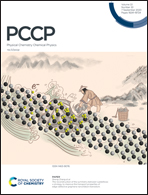X-ray Raman scattering for bulk chemical and structural insight into green carbon†
Abstract
X-ray Raman scattering (XRS) spectroscopy is an emerging inelastic scattering technique which uses hard X-rays to study the X-ray absorption edges of low-Z elements (e.g. C, N, O) in bulk. This study applies XRS spectroscopy to pyrolysis and hydrothermal carbons. These materials are thermochemically-produced carbon from renewable resources and represent a route for the sustainable production of carbon materials for many applications. Results confirm local structural differences between biomass-derived (Oak, Quercus Ilex) pyrolysis and hydrothermal carbon. In comparison with NEXAFS, XRS spectroscopy has been shown to be more resilient to experimental artefacts such as self-absorption. Density functional theory XRS calculations of potential structural sub-units confirm that hydrothermal carbon is a highly disordered carbon material formed principally of furan units linked by the α carbon atoms. Comparison of two pyrolysis temperatures (450 °C and 650 °C) shows the development of an increasingly condensed carbon structure. Based on our results, we have proposed a semi-quantitative route to pyrolysis condensation.



 Please wait while we load your content...
Please wait while we load your content...